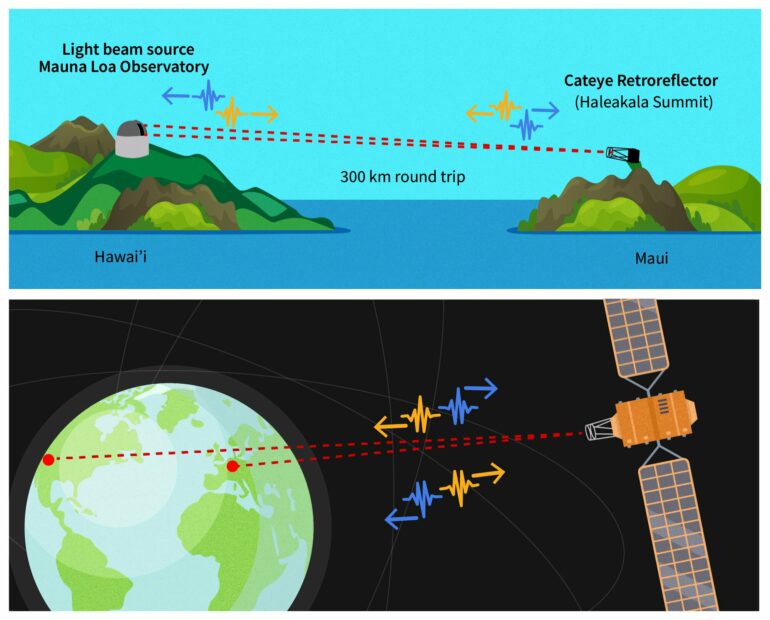Last year, scientists drove up Mauna Loa volcano on Hawai’i, aimed a laser at a reflector positioned on Haleakala peak on Maui, and beamed rapid pulses of laser light through 150 kilometers of turbulent air. While the pulses were exceedingly faint, they demonstrated a capability long sought by physicists: transmitting extremely precise time signals through the air between far-flung locations at powers that are compatible with future space-based missions.
The results, obtained by a team including scientists from the National Institute of Standards and Technology (NIST), could enable time transfer from the ground to satellites 36,000 kilometers away in geosynchronous orbit, where they hang stationary above a point on the Earth’s surface. The method would permit this time synchronization with femtosecond precision—10,000 times better than the existing state-of-the-art satellite approaches. It also would allow for successful synchronization using the bare minimum timing signal strength, which would make the system highly robust in the face of atmospheric disturbances.
Coordinating arrays of distant devices to this substantially higher degree offers several intriguing possibilities. While the latest optical atomic clocks are extraordinarily precise, comparing clocks that are separated by continents requires a signaling method that can convey that precision across great distances, and the current microwave-based methods do not provide the necessary fidelity.
The new approach could allow optical clocks on opposite sides of the planet to be linked through a geosynchronous satellite without any such penalty, supporting the future redefinition of the SI second to an optical standard. Linking optical atomic clocks around the globe could also lead to a range of fundamental physics measurements from exploring dark matter to testing general relativity.
Not all possibilities would require optical atomic clocks: The ability to sync up an array of widely separated sensors could advance very long baseline interferometry (VLBI) for applications such as the improved imaging of black holes.
“This sort of distributed coherent sensing would be unprecedented,” said Laura Sinclair, a physicist at NIST’s Boulder campus and an author of the team’s research paper, which appears today, June 21, in the journal Nature. “We envision using these sensor arrays to look up at space and down at the Earth. Implementing these arrays depends on connecting highly accurate optical clocks, and our results indicate that we now have a tool capable of doing that.”
The experiment showed that the high-frequency time signal provided by an optical clock can be sent and received by the team’s most recent creation, the time programmable frequency comb, which is an innovation on frequency comb technology. It was this novel frequency comb that made the results possible, Sinclair said.
“The expanded functionality of the time programmable frequency comb let us make these measurements,” Sinclair said. “We couldn’t have obtained these results without it.”
A light beam traveling from Earth to geosynchronous orbit needs to pass through the often cloudy, roiling layers of our atmosphere. To demonstrate in principle the signal’s capability of reaching a satellite without getting lost in transit, the team set up its novel frequency comb and a reflector on two mountains 150 km apart: high on the flank of Mauna Loa and at the summit of Haleakala, both in Hawai’i. Sending the time programmable frequency comb light to Haleakala and receiving the reflection demonstrated that the signal could penetrate much more atmospheric trouble than it would encounter traveling to geosynchronous orbit.
Not only did the round trip succeed, but it did so even at the bare minimum signal strength necessary to synchronize devices—an intensity that physicists refer to as the “quantum limit.” As they showed in their previous work, the researchers’ time programmable frequency comb is capable of operating at this quantum limit, where fewer than one photon in a billion reaches its target device. It worked even when the laser was sending out only 40 microwatts of power, or about 30 times less than a laser pointer uses. (The frequency comb’s pulses are infrared light, invisible to the naked eye.)
“We wanted to push the system to its limits, and we’ve shown you can keep a high level of performance while using a transmission power and aperture size that are realistic for future satellite systems,” Sinclair said. “The robustness of this system to operate well not only when we receive less than a billionth of the light we transmit, but also when the amount of light we lose is changing rapidly, bodes well for forming the timing backbone of future sensing networks.”
Looking forward, the NIST team is working to reduce the size, weight and power of its system, and to adapt it to work with moving platforms.
More information:
Laura Sinclair, Quantum-limited optical time transfer for future geosynchronous links, Nature (2023). DOI: 10.1038/s41586-023-06032-5. www.nature.com/articles/s41586-023-06032-5
Provided by
National Institute of Standards and Technology
Citation:
Team lays groundwork for future ultra-precise timing links to geosynchronous satellites (2023, June 21)



